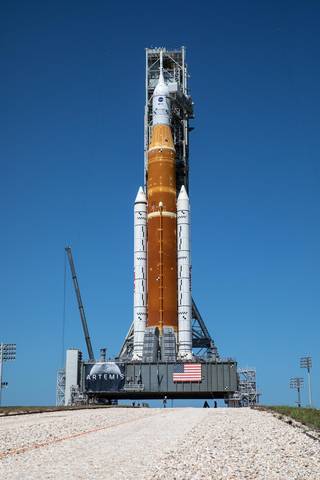HUNTSVILLE — When NASA’s Artemis I mission launches Aug. 29, thousands of cameras will capture the historic first flight of NASA’s Space Launch System rocket and Orion spacecraft.
Some cameras, though, are focused on carefully placed markings on the rocket, spacecraft, and mobile launcher. These cameras aim to capture portions of the countdown and launch and will provide valuable data to engineering teams following launch and flight.
A variety of black-and-white patterns are painted on the rocket and spacecraft and used as targets for the cameras. Some designs, like the checkered rings on each solid rocket booster, are used by cameras on the rocket. In the case of the black ring below the nose cone on the left-hand solid rocket booster, it allows the engineers to easily distinguish the right booster from the left since the vehicle is very symmetric and some of the cameras will have a tight field of view. Other patterns, though, are best viewed at a distance.
“If you look at the SLS core stage and the twin solid rocket boosters, launch pad, and launch tower, you will see alternating black and white squares that appear like checkerboard patterns,” said Beth St. Peter, SLS imagery integration team lead at NASA’s Marshall Space Flight Center. “Each marking has a specific purpose. In general, the markings are used to precisely measure motion during dynamic events during liftoff and separation.
“With specific cameras, we will track those cross hairs of the markings and form “triangles” of multiple patterns to help with our post flight reconstruction analysis tasks.”
Critical events, such as solid rocket booster separation from the core stage, will be closely studied and compared with computer model simulations.
“Imagery and data we collect will help validate the computer models, and we might even find that we can relax some of the constraints based on the photogrammetry data,” St. Peter said.
The shape of each pattern is also important. Squares and rectangles provide sharp edges, which allow computer software to precisely determine pixel edges and, by extraction, movement of those pixels. Black and white patterns are used because the two colors provide the most contrast, which helps ensure the teams are tracking the same point over time and also from multiple cameras.
A picture is worth a thousand words.
For engineers building, launching, and flying the rocket that will enable NASA’s next era of space exploration, a photo is worth a thousand data points. Data points that will land the first woman and first person of color on the Moon and send humanity further out in the solar system than ever before.
To learn more about SLS, visit: https://www.nasa.gov/exploration/systems/sls/index.html
To learn more about the Artemis I mission, visit: https://www.nasa.gov/artemis-1
Don’t miss out! Subscribe to our email newsletter to have all our smart stories delivered to your inbox.



